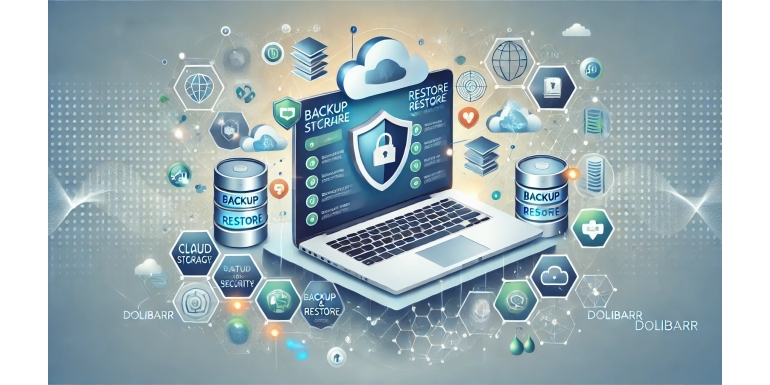
In today’s business environment, data backup and restoration are critical aspects of ERP management. A technical failure, human error, or cyberattack could result in irreversible data loss, causing major disruptions in an organization.
This article explores the best practices for ensuring data security in Dolibarr, covering backup strategies, restoration methods, and recommended tools to minimize risks.
1️⃣ Why is Data Backup Essential in Dolibarr?
Dolibarr ERP stores a large amount of critical business data, including:
✔ Accounting and financial data (invoices, quotes, payments).
✔ Customer and supplier information (history, contracts, contacts).
✔ Stock and commercial management data.
✔ Human resources data (payroll, employees, leave records).
Without a proper backup strategy, a server crash, accidental deletion, or cyberattack could cause irreversible data loss.
✅ Consequences of Data Loss Without Backup
❌ Business downtime, impacting productivity.
❌ Loss of customer and financial data, affecting billing and operations.
❌ Legal and regulatory compliance issues due to missing critical records.
❌ High recovery costs, if data restoration is even possible.
A solid backup policy ensures business continuity and protects the company from these risks.
1️⃣ Backup Strategies in Dolibarr
There are multiple ways to back up Dolibarr data. Here are the most effective methods:
1.1 Manual Backup via Dolibarr
Dolibarr provides a built-in backup feature, accessible from the admin panel.
Steps to perform a manual backup:
1️⃣ Log in to Dolibarr’s admin panel.
2️⃣ Go to Admin Tools > Database Backup.
3️⃣ Select Export Database.
4️⃣ Download and store the generated SQL file in a secure location.
???? Advantages:
✔ Simple to execute without technical expertise.
✔ Useful for creating a backup before updates or changes.
❌ Disadvantages:
❌ Risk of human error if backups are not performed regularly.
1.2 Automated Backup with Cron Jobs
Automating backups via a Cron Job script ensures continuous data protection.
How to set up automatic backups:
- Configure a Cron Job to execute a MySQL backup command.
- Save the .sql file to a remote server or cloud storage.
- Schedule the task to run daily or weekly for optimal security.
???? Advantages:
✔ No manual intervention required.
✔ Reduces the risk of missed backups.
❌ Disadvantages:
❌ Requires basic Linux administration skills.
1.3 Full Backup: Database + Dolibarr Files
Besides database backups, it is essential to back up the following Dolibarr files:
- Configuration files (
conf.php). - Folders containing generated documents (
/documents/). - Custom modules and extensions (
/htdocs/custom/).
???? Recommended approach:
Use rsync or software like Rclone to automatically copy these files to a secure server or cloud storage (Google Drive, Dropbox, AWS S3).
1️⃣ Best Practices for Securing Backups
To ensure maximum protection, follow these essential recommendations:
1.4 Follow the 3-2-1 Backup Rule
???? The 3-2-1 backup strategy:
✔ 3 copies of the data (1 primary + 2 backups).
✔ 2 different storage media (local server, cloud storage).
✔ 1 offsite backup (external server or offline hard drive).
This rule prevents total data loss in case of disasters.
1.5 Encrypt Backup Files
- Use GPG or OpenSSL to encrypt SQL files before storing them.
- Enable server-side encryption for cloud-stored backups.
1️⃣ Restoring Data in Dolibarr
In case of data loss or system failure, it is crucial to know how to restore Dolibarr quickly.
2.1 Manual Restoration via phpMyAdmin
1️⃣ Log in to phpMyAdmin or your MySQL management tool.
2️⃣ Select the Dolibarr database.
3️⃣ Import the SQL backup file.
4️⃣ Verify data integrity after the restoration.
???? Best for:
✔ Simple recovery after an update failure.
2.2 Restoration via Command Line
1️⃣ Connect to the server via SSH.
2️⃣ Run the following command:
3️⃣ Restore Dolibarr files and folders (htdocs, documents).
???? Advantages:
✔ Faster and ideal for large databases.
2.3 Regularly Test Data Restoration
???? Key recommendation:
- Perform test restores on a staging environment.
- Ensure that all data (invoices, users, permissions) is correctly restored.
1️⃣ Recommended Backup and Restoration Tools
???? Essential backup and restoration software and scripts:
| Tool | Purpose |
|---|---|
| mysqldump | Fast SQL backup via command line |
| Rclone | Backup to cloud storage (Google Drive, AWS S3) |
| Bacula | Advanced enterprise-level backup solution |
| Duplicati | Automated and encrypted backups |
| AutoMySQLBackup | Scheduled MySQL backups |
1️⃣ Conclusion: Ensuring Long-Term Data Protection in Dolibarr
⭐ Backing up and restoring Dolibarr data is essential for data security and business continuity.
???? Key takeaways:
✔ Automate backups to avoid human errors.
✔ Follow the 3-2-1 backup strategy to ensure redundancy.
✔ Regularly test data restoration to confirm its reliability.
✔ Encrypt and secure backups to prevent cyber threats.
✅ By following these best practices, businesses can ensure seamless operations even in the face of technical failures or security incidents.
???? What backup strategy do you use for Dolibarr? Share your tips and experiences in the comments!
